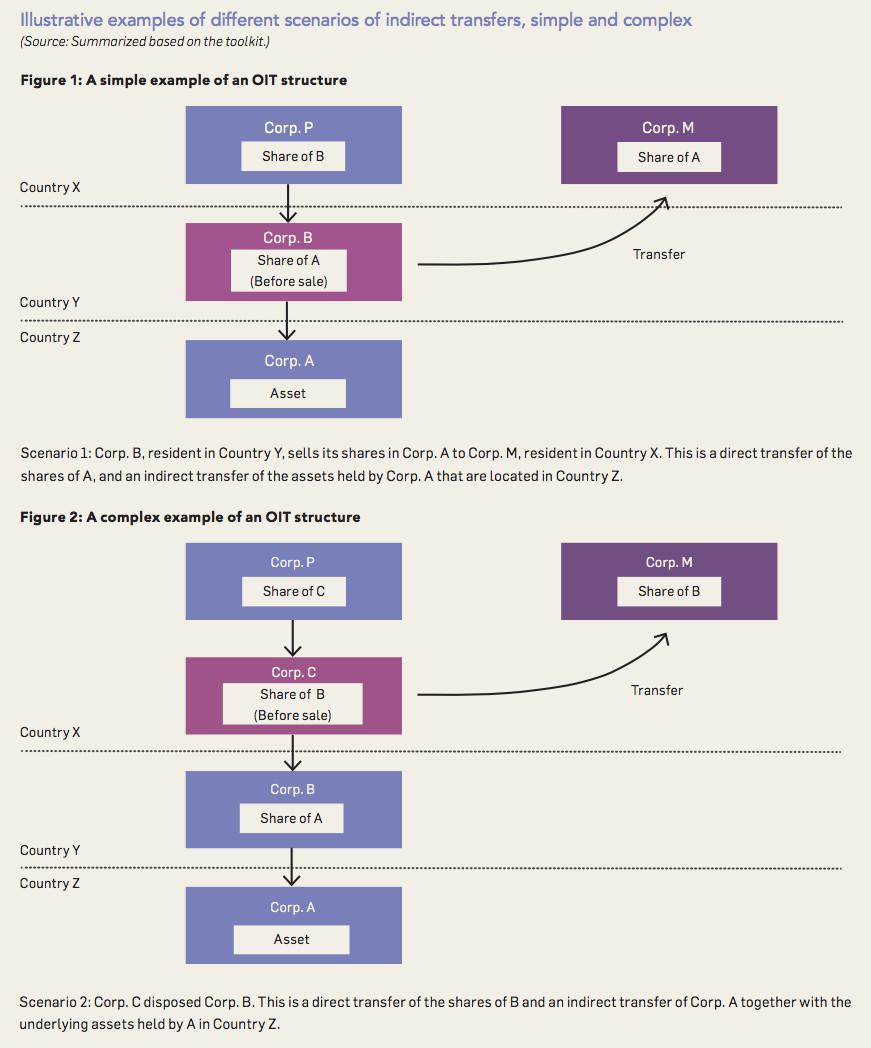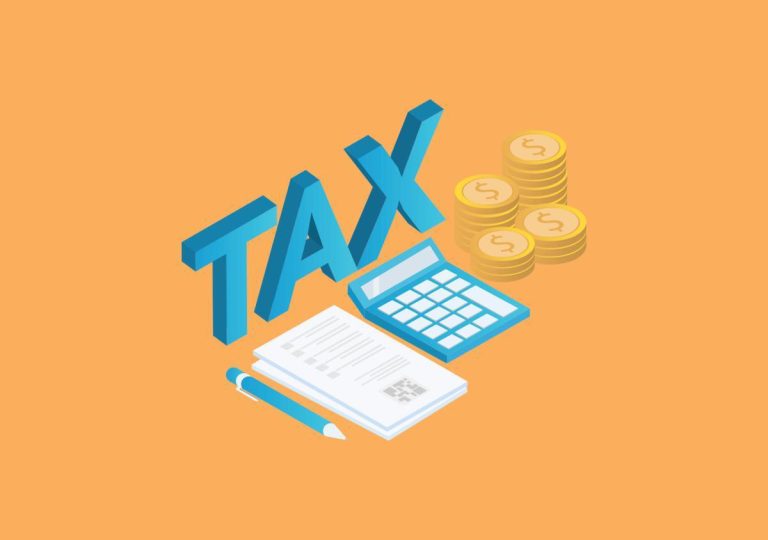In June, the Platform for Collaboration on Tax (PCT), co-founded by the International Monetary Fund, Organization for Economic Cooperation and Development (OECD), World Bank Group and the United Nations (UN), released a toolkit on the taxation of offshore indirect transfers (OITs) providing guidance on tax treatment and implementation issues for developing countries when one country seeks to tax gains on the sale of interests in an entity owning assets located in that country by an entity which is a tax resident of another country.
The toolkit is a technical reference or guidance instead of a law or an agreement with binding powers. In the absence of appropriate legal basis under domestic law to assert the taxing right on OITs, tax certainty cannot be assured. Nonetheless the guidance is welcomed by the tax professional community.
Background
OITs, defined in the toolkit as “disposition of an indirect ownership interest in an asset, in whole or in part, in which the transferor of the indirect interest is resident in a different country from that in which the asset in question is located,” have emerged as a significant issue in many developing countries. Tax administrations may find tax collection on OITs a difficult task due to the complications, complexities and technical judgements involved. For taxpayers, different definitions, scope of taxable assets and interpretations in domestic laws in different jurisdictions lead to uncertainties.
Taxation on OITs often relates to taxation on non-residents, which usually involves the allocation of taxing rights and economic interests between two or more jurisdictions. A more uniform approach to OIT taxation at the international level is therefore urgently required.
It is accepted by the Model Tax Conventions (MTCs) of the OECD and the UN that capital gains derived from OITs of “immovable” assets can be taxed by the asset location country.
The toolkit provides analysis of two options for OIT taxation, with a focus on the perspective of developing countries. The key questions addressed include:
- What considerations arise in deciding whether transfers should be taxed in the country in which the underlying asset is located?
- Which types of assets should be included in the OIT taxation bases?
- How can such taxation, if adopted, be best designed and implemented from practical and legal points of view?
The toolkit proposes that location countries may wish to tax OITs of at least those assets which are immovable, i.e. within the meaning defined in both of the OECD and UN MTCs, and perhaps other assets that also generate location-specific economic income.
The toolkit suggests two models for domestic legislation for location countries wishing to extend their taxing rights. The toolkit also provides enforcement and tax collection guidance.
As previously stated, some location countries may wish to tax gains realized on OITs as is currently the case for direct transfers of immovable assets. Those location-specific incomes exceed the minimum returns projected by the investors and cannot be generated in other jurisdictions. These assets might include, for instance, telecommunication licenses and other rights granted by local governments.
The PCT advocates that location countries should have the right to tax OITs, and such assets should at least include property that generate location-specific income (such as natural resources, including physical property and related rights, regional telecom licenses or other rights), including those thoughts of as “immovable property,” regardless of whether equivalent tax in regard to the transfer would be paid elsewhere. In other words, such taxation could apply not only as an anti-avoidance device to combat “double non-taxation,” but rather could constitute a fundamental aspect of the country’s domestic tax laws.
The two OIT taxation models
The toolkit provides two OIT taxation models, which are not mutually exclusive. However, if both models are adopted, an ordering rule is required to ensure they do not apply at the same time. Appropriate enforcement and collection rules are also critically important.
The detailed treatments, tax enforcement and collection rules under these two models are discussed below:
Model 1: impose tax on a local asset-owning entity and treat it as disposing of and reacquiring the assets (e.g. Corp. A in Figures 1 and 2 on illustrative examples below)
Model 1 is designed to tax the actual owner of the assets (e.g., Corp. A), rather than the non-resident seller, by treating the actual owner as disposing of and reacquiring the assets for their market values.
Tax treatment under Model 1
Key technical points regarding tax treatments under Model 1 are summarized as follows:
- Tax the unrealized gain, recognize losses where there are no accrued gains.
- Safe harbour rules may apply on corporate reorganization.
- Tax liability is triggered if the sale led to effective change in control by more than 50 percent.
- Change of control – the toolkit encourages jurisdictions to include definitions for “ownership” or “change of ownership” in the relevant domestic provisions.
- Deemed disposal of assets – where a change of control occurs, the local assets owner is deemed as disposing of the assets for their market value.
- Reacquiring the assets – the local entity is regarded as reacquiring the assets at the market value during the indirect transfer to avoid double taxation in subsequent change of control.
- Resetliabilities – both assets and liabilities of the local asset-owning entity are reset for ease of administration.
The introduction of domestic tax provisions does not involve complex issues such as corporate reorganizations, minority shareholders, joint venture arrangements, valuation difficulties, listed securities, and the treatment of losses under Model 1. Countries could introduce carve out rules according to their individual circumstances so as to effectively address concerns such as scenarios where the change of ownership is triggered by an initial public offering.
Under Model 1, the local asset-owning entity shall be subject to the ordinary compliance rules applicable to resident taxpayers.
Comments on Model 1
The application of Model 1 is relatively simple. However, there are certain shortcomings, namely:
- Double taxation may arise as the non-resident seller may have to pay tax in its residence country but there would be no foreign tax relief available for the seller as they are not liable for taxes in the local asset-owning country.
- As the local asset-owning entity is not the entity receiving the proceeds from the OIT, it may have liquidity problems in meeting the tax payments.
- Model 1 undermines the functions and risks of the separate legal entities, specifically at the relevant tiers of investment holding entities.
- The compliance burden on the local asset-owning entity may increase as it has to monitor the changes of its own ownership over which it has no control.
Model 2: tax the non-resident seller (e.g. Corp. B in Figure 1 and Corp. C in Figure 2 in above diagram)
The OIT is treated as being made by the non-resident seller (the actual seller), but the gain is deemed as sourced from the country where the assets locate. As shown in Figure 1, the gain realized by Corp. B (Country Y resident) shall be seen as sourced from Country Z where the assets are located, thus Country Z shall have the right to impose tax.
Tax treatment under Model 2
The source rule is combined with the taxable asset rule:
- Source rule: The entire gain shall be subject to tax in Country Z when the value of the share transferred is principally (e.g. more than 50 percent) derived from the assets in Country Z.
- Taxable asset rule: under a taxable asset rule, Country Z may choose to tax the entire gain or on a proportionate basis by considering factors such as the proportion of value attributed to the assets.
When formulating domestic tax rules, countries shall take into account any existing tax treaty obligations.
With respect to the scope of the interest which is to be subject to tax in Country Z, Model 2 provides three options:
- All interests, provided the value of the interest sold is principally (over 50 percent) derived from that asset.
- Only more significant interests (e.g. interests of 10 percent or more of the asset).
- Interest with the nominal value over certain threshold (e.g. US$1 million).
Exemptions are suggested to certain transfers such as transfer of shares of companies listed on a stock exchange or shares transfer in the course of a corporate reorganization, etc.
Enforcement/collection rules under Model 2
The non-resident seller who needs to pay tax in Country Z due to an OIT usually needs to file a tax return in Country Z. A withholding or notification/reporting mechanism can be established to promote the tax enforcement/collection and improve tax compliance, for example, control measures on local asset registration change.
Comments on Model 2
Unlike Model 1, Model 2 preserves the separate legal entity distinction between the local asset-owning entity and its relevant tiers of parent entities. The non-resident seller can claim foreign tax credit in its resident country, which effectively avoid double taxation.
However, Model 2 is more demanding for tax administrations. The compliance burden on local asset-owning entity is increased for monitoring ownership changes. Besides, double taxation may arise on subsequent disposal of interests in transferees (e.g. Corp. M) as assets after the OIT will not be stepped up to market value.
Points to note
The toolkit represents the analysis and conclusions of the tax staff of the PCT’s four partner organizations but not necessarily the official views of the organizations’ member countries. Further, the cases in the toolkit are solely for illustration purposes and should not be relied upon for other purposes. The appropriate choice among the two models will depend on countries’ circumstances and considerations. The toolkit does not provide a one-size- fits-all solution.
Developing countries in general have concerns that OITs might be used inappropriately to avoid capital gains taxation in the assets location country. This issue is not covered in the OECD’s Base Erosion and Profit Shifting (BEPS) project, but it has been identified by developing countries as significant. This toolkit is for developing countries to assist their responses to international tax issues, which the BEPS project has not addressed.
The toolkit mentioned that a general anti-avoidance rule (GAAR) could be used as a last resort to tax an OIT gain in appropriate circumstances. However, it may not be easy for countries with a weak administrative capacity to apply a GAAR rule successfully.
Some countries have adopted taxing mechanisms that operate in a similar way to a GAAR by seeking to, in effect, collapse the multi-layer holding structure and treat the ultimate non-resident seller of the interests as the seller of the local assets, who realizes a gain with a local source. Application of this kind of rule is dependence on successful establishment of international tax avoidance is involved. Otherwise, asset location country may not have the taxing right on the OIT gain. Hence, the toolkit considers this kind of rule only have limited scope application.
In Mainland China, the corporate income tax (CIT) regime provides that gains on direct transfers of assets located in China shall be taxed. The prevailing Public Notice 7 – a circular issued under GAAR – further specifies that OIT by non-resident person without reasonable commercial purpose but merely used to avoid CIT shall be re-characterized as a direct transfer of a China taxable asset. The taxing mechanisms adopted by China is to collapse the multi-layer holding structure and treat the ultimate non-resident seller as the seller of the local assets, who realizes a gain with a local source.
The toolkit commended the Chinese approach to indirect transfers of assets as relatively defensive and discretionary: OITs may be taxed if they are deemed to be structured to evade paying tax in China. The tax certainties of this kind of approach might be a concern to taxpayers if there is no enough detailed and consistent interpretations and implementation guidance at the state level.
Conclusion
The toolkit provides technical reference for both administrators and taxpayers, especially in the case of disputes over taxing rights. Location countries should have the right to tax OITs, and such assets should at least include property that generate location-specific income (such as natural resources, including physical property and related rights, regional telecommunication licenses or other rights). However, this does not mean that location countries should always tax OITs. Non-tax factors such as capacity, needs of tax revenue and sentiments of foreign investment, etc. should also be considered.
A more uniform and coordinated approach to OIT taxation can contribute to coherence in international tax arrangements and enhance tax certainty. Furthermore, it is necessary to formulate a clear and uniform interpretation of domestic laws and regulations to avoid uncertainty and unfairness in implementation of the provisions.
This article is contributed by Jane Hui, Leader of China Tax Centre and Partner, International Tax and Transaction Services, of EY
















